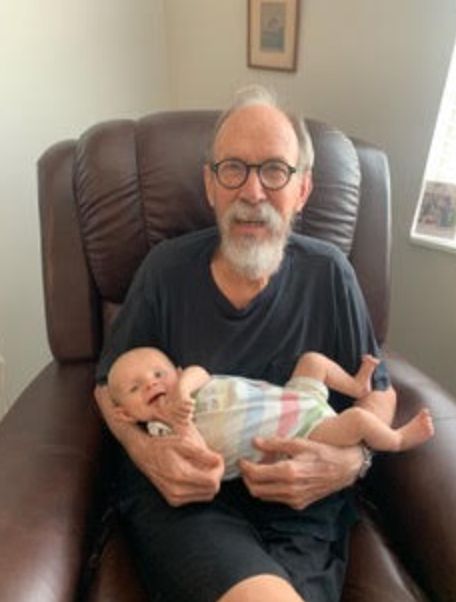
Lee died in February. We celebrated his life the Saturday before Father’s Day. I should have been grieving. Instead, I was taking delivery of flowers and preparing brisket for the get-together after the service. I was hugging siblings and grandchildren and neighbours. I was emailing old colleagues and setting up Zoom links for distant friends. But that was OK; I had been grieving my loss of Lee for a very long time — indeed, for the years spanning the distance between middle and old age. I may never completely finish that process, but it certainly is not new; I’m kind of used to it anyway.
I am a historian. My world is structured by events and dates. Lee and I met in 1977 and married in 1978. I was 26 and he was 36. Our four sons were born between 1980 and 1983. (Yes, the youngest are twins.) We rode out lots of ups and downs and managed to stay married until 2010, when we divorced.
Our split was horribly painful; it was hard to disentangle 32 years of friends, possessions and expectations. We generated enough anger and resentment to flood the gulf of silence between us. Lee had two important committed relationships with women after the divorce, further cementing our estrangement.
We had virtually no contact until our twins’ weddings in 2016 forced a rapprochement. From that point onward, interaction became easier. Conversation was initially awkward, then slid into familiar patterns. Old memories created scaffolding for a tentative new friendship. We even danced with each other. It all felt grown-up, civilised and oddly easy. He didn’t have to hate me any more. I didn’t have to dread his bad behaviour or be responsible for him.
Then, in 2019, shortly before his 78th birthday, Lee was diagnosed with Parkinson’s disease and Lewy body dementia. No one was surprised; he had been showing signs of cognitive slippage for years. But his girlfriend contacted our sons and me, telling us about his diagnoses and explaining that she could not take on his care.
This was an enormously wise and loving thing to do, helping to focus family concern and jump-start legitimate intervention. Rather to everyone’s surprise, including mine, it turned out that I was still part of Lee’s family.
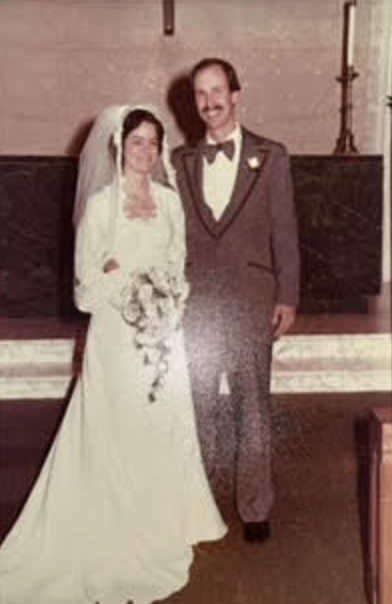
Lee was not an easy guy to help. He had an Ivy League Ph.D. and the ego to go with it. He had a terrible temper. He drank too much. He dominated conversations and was always sure he was right about everything.
Although he was also charming and lots of fun, his diagnoses scared him and made him see enemies everywhere he looked. Doctors had misdiagnosed him. The state, quite unjustly, wouldn’t let him keep driving. His sons were conspiring to break up his romantic relationship and keep him from going from Wisconsin to Arizona for the winter. But, for some reason, he would listen to me.
I convinced him — over and over again — that it didn’t make practical sense for him to move to Arizona. And I began to think about relocating to Minneapolis, where I could be nearer to our grandchildren and help with Lee’s care.
Even before I moved, I started to help. I spent three weeks in Lee’s house, clearing it out so that it could be put up for sale. I got rid of his library, which filled four rooms. I made endless trips to charity stores to dispose of the clothing and household goods Lee would never use again.
Perhaps, most importantly and painfully, I went through his paper files. This needed to be done page by page, because Lee had kept copies of all of his financial documents, including personal checks, since our separation. These were mixed with correspondence, printouts of bibliographical searches, and 50 years of research notes and teaching materials.
Lee saved and filed everything. During his last few years of independence, he lost the ability to prioritise or categorise anything. His home became a physical map of his disease — cluttered, disordered, dirty and terribly sad. I wept as I burnt out two shredders and drove repeatedly to the recycling centre 13 miles away. That gorgeous big brain of his had left home long before Lee did. Going, going, gone.
I closed the door of Lee’s quiet, clean, empty house and went back to my home in Wyoming. The boys told me Lee was doing well, settling into his one-bedroom apartment in a nice new downtown building. I got a puppy and did lots of cross-country skiing.
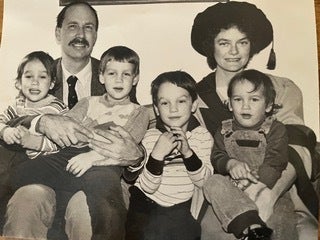
Then Covid descended. So, on March 20, 2020, I packed up the dog and drove 1,000 miles to Minneapolis, planning to help care for my two granddaughters, then aged 2 and 4, so that their parents could work from home, and I could be near family during the pandemic.
Our local son and daughter-in-law had been Lee’s nearest relations and family support system for years. He went to my daughter-in-law’s parent’s home for holiday meals; our son clipped Lee’s awful toenails and got his hair cut. However, the pandemic and my move to Minneapolis changed things. Everybody needed more help. And Lee was getting sicker.
At first, I did things that were easy for me, like finding new health care providers for him: a new primary care doc. A new neurologist. A new ophthalmologist. A new dentist. When Lee became too confused to live independently, I helped to find a memory care facility for him. Then, hands-off gradually became hands-on.
As the pandemic eased, I took him to medical appointments and became both his health care advocate and the family interpreter and communicator of his medical information. I often drove him to and from family social events. We went out to lunch. I bought clothes for him and tried to organize his hopelessly muddled closet and cupboards. I comforted his terrible anxiety about his phone, his wallet, his watch, his belt, his lists.
Parkinson’s disease and Lewy body dementia are horrible. There are drugs that mask symptom progression for awhile, but the damage is ongoing and relentless. Lee lost so much of what had made him Lee during the three-and-a-half years between diagnosis and death.
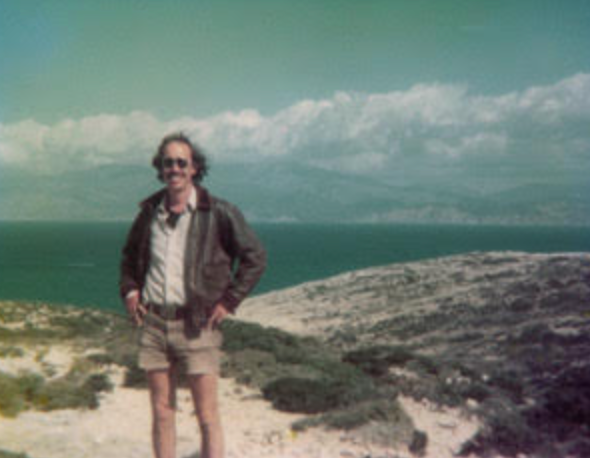
Early on, due to short-term memory loss, he stopped being able to read and write, follow a televised sports event or enjoy an old movie. His 6-foot, 3-inch frame bent and stiffened until he could not move or sit without pain. He could neither walk faster than a shuffle, nor could he easily seat himself or rise from a chair. Getting in and out of a car was a miserable ordeal. And the emotional aspects were as awful as the physical ones. Lee was bored, anxious and depressed.
But his amazing long-term memory outlived almost every other part of his personality. And I was the only one around who shared familiarity with the people, places and events of his past. Almost until he lost the ability to speak, we would chat about old colleagues and friends, ideas for research projects and trips we’d taken. Through those slow, rambling, quiet conversations, Lee held on to his identity and I found that the things fractured by our separation and divorce began to heal.
One of those things was the family we had made together. Our sons had been adults when we separated, but they continued to suffer the pain and betrayal that came with the divorce. They had seen our marriage and family as special, unusual, and somehow indestructible. They had not seen the fissures in that carefully constructed edifice — fissures I had done my best to hide from them.
The sense of betrayal cut deep, and was compounded by Lee’s endless — and, ultimately, unsuccessful — efforts to find a new last partner: a woman who would put up with and take care of him. Our sons had to tolerate, and sometimes embrace, Lee’s ladies. At the same time, while being loyal to their dad, they maintained strong loving relationships with me.
An important and unexpected benefit of my involvement in Lee’s end-of-life care was a kind of family reunification. The out-of-town boys visited. We spent some holidays together and passed grandchildren from one elderly set of knees to another at Sunday dinners and backyard barbecues. We reminisced about that long-ago Christmas when we were all sick, wore our pyjamas all day, and watched movies, cuddled up on the sofa. We took some sweet group photographs and consulted, with loving tears, about Dad’s care. And by the time the end came, we faced and experienced it together.
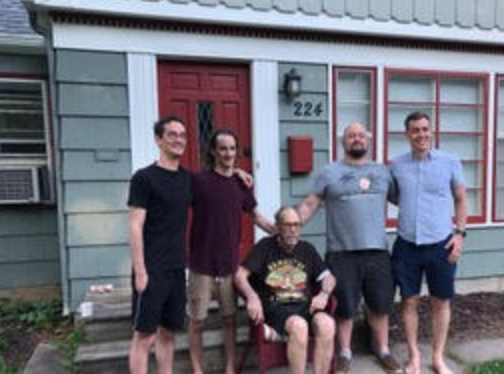
Just before Thanksgiving 2022, I got a call from the memory care nurse at about 1 p.m. Lee hadn’t moved from his recliner all day. He hadn’t come to meals. He was not talking. Could I come?
This was the beginning of the last stage. Hospice care. Emotional family goodbyes. A strange holiday season. The long wait that became everyday life.
I grew used to perching on Lee’s wheelchair next to his hospital bed and feeding him tiny pinches of coffee cake from my fingers. I asked the kind, knowledgeable hospice nurses about ways to prevent pressure sores. I requested the relentless increases in morphine doses to ease Lee’s discomfort. And I did what people have done for dying loved ones since the beginning of human time: waited for the end.
It came on a sunny February afternoon. Our eldest son had arrived from California the day before. He was with Lee when he died.
I say “loved ones.” There are many kinds of love. At some point during the last couple of years, Lee asked me, “What is our relationship now?” And I responded, “We are dear old friends.” That was as true as it could be. Lee introduced me to his caregivers as his wife; that was also true in some important ways. It was not legally accurate, but it expressed the central fact that Lee and I were married for most of our adult lives. He was with me when our children were born. I knew his body as completely as I knew my own. Divorce does not erase lived experience.
As I planned Lee’s celebration of life, I considered the fact that I am not alone. There are many old people out there — mainly women, I suspect — caring and grieving for former spouses. We do this for many reasons; chief among them is love: love remembered, love honoured.
I’m glad you’re at peace, old man. Flights of angels sing thee to thy rest.
Born and raised in the Chicago suburbs, Lucinda Myles McCray is a historian of medicine and public health who spent her professional life at British and American universities as a researcher, administrator and faculty member. The author of numerous books, articles and opinion and personal pieces, she now lives with her dog, Molly, in Minneapolis, reading, writing, grandmothering and spending as much time as possible outdoors.